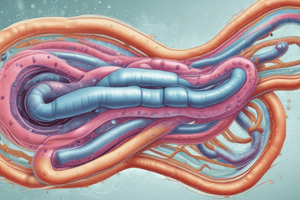Podcast
Questions and Answers
What is the primary basis for dividing V.cholerae O1 organisms into different serotypes?
What is the primary basis for dividing V.cholerae O1 organisms into different serotypes?
The composition of the O antigen.
What is the significance of V.cholerae O1 in terms of cholera?
What is the significance of V.cholerae O1 in terms of cholera?
It is the causative agent of cholera, also known as Asiatic cholera or epidemic cholera.
What is the name of the current pandemic of cholera that originated in Indonesia in 1961?
What is the name of the current pandemic of cholera that originated in Indonesia in 1961?
The seventh pandemic of cholera.
What is the common antigen shared by the three major subgroups of V.cholerae?
What is the common antigen shared by the three major subgroups of V.cholerae?
What is the purpose of serotyping V.parahaemolyticus?
What is the purpose of serotyping V.parahaemolyticus?
What is the term for strains of V.cholerae that fail to agglutinate in O1 antisera?
What is the term for strains of V.cholerae that fail to agglutinate in O1 antisera?
What was the time period when cholera returned to South America?
What was the time period when cholera returned to South America?
What is the main mode of transmission of cholera?
What is the main mode of transmission of cholera?
What is the characteristic of stools produced by patients with cholera?
What is the characteristic of stools produced by patients with cholera?
What is the powerful enterotoxin responsible for the devastating clinical scenario of cholera?
What is the powerful enterotoxin responsible for the devastating clinical scenario of cholera?
What is the primary goal of treatment and management of cholera?
What is the primary goal of treatment and management of cholera?
What is the purpose of administering antimicrobial agents in cholera treatment?
What is the purpose of administering antimicrobial agents in cholera treatment?
Flashcards are hidden until you start studying
Study Notes
Antigenic Structure of Vibrio
- Limited knowledge on antigenic structure of Vibrio, except for V. cholerae, V. parahaemolyticus, V. fluvialis, and V. vulnificus
- V. cholerae has three major subgroups: V. cholerae O1, V. cholerae O139, and V. cholerae non-O1, sharing a common flagellar (H) antigen and somatic (O) antigen
- V. cholerae O1 divided into serotypes based on O antigen composition: Ogawa (A, B), Inaba (A, C), and Hikojima (A, B, C)
- V. parahaemolyticus serotyped using O and K (capsule) antigens, mainly during epidemiologic studies in reference laboratories
Epidemiology of Vibrio cholerae
- V. cholerae O1 causes cholera, a disease of major public health significance, endemic in developing countries, particularly in the Bengal region of India and Bangladesh
- Seventh and current pandemic originated in Indonesia in 1961, spreading throughout Asia and Africa, and later to South America and Central America
- Cases of cholera rare in the United States, mostly reported as imported cases
Clinical Manifestations of Cholera
- Cholera is an acute diarrheal disease, mainly spread through contaminated water, and sometimes through improperly handled foods
- Symptoms include severe gastroenteritis, vomiting, and diarrhea, with characteristic "rice water stools" and frequent bowel movements (10-30 per day)
- If untreated, cholera can lead to rapid fluid and electrolyte loss, dehydration, hypovolemic shock, metabolic acidosis, and death within hours
- Caused by the powerful enterotoxin choleragen, produced by V. cholerae in the small intestine, which leads to hypersecretion of electrolytes and water into the intestine
Mechanism of Cholera Toxin
- Choleragen consists of two toxic A subunits and five binding B subunits
- B subunits bind to GM1 ganglioside receptor on the cell membrane, allowing A2 subunit to facilitate entrance of A1 subunit into the cell
- Active A1 subunit stimulates production of adenylate cyclase, leading to accumulation of cyclic adenosine monophosphate (cAMP) and hypersecretion of electrolytes and water into the intestine
Treatment and Management of Cholera
- Treatment involves administration of large amounts of intravenous or oral fluids to replace lost fluids
- Antimicrobial agents like doxycycline can shorten duration of diarrhea, but resistance has been reported, and additional antimicrobials like azithromycin and ciprofloxacin may be used
Studying That Suits You
Use AI to generate personalized quizzes and flashcards to suit your learning preferences.




